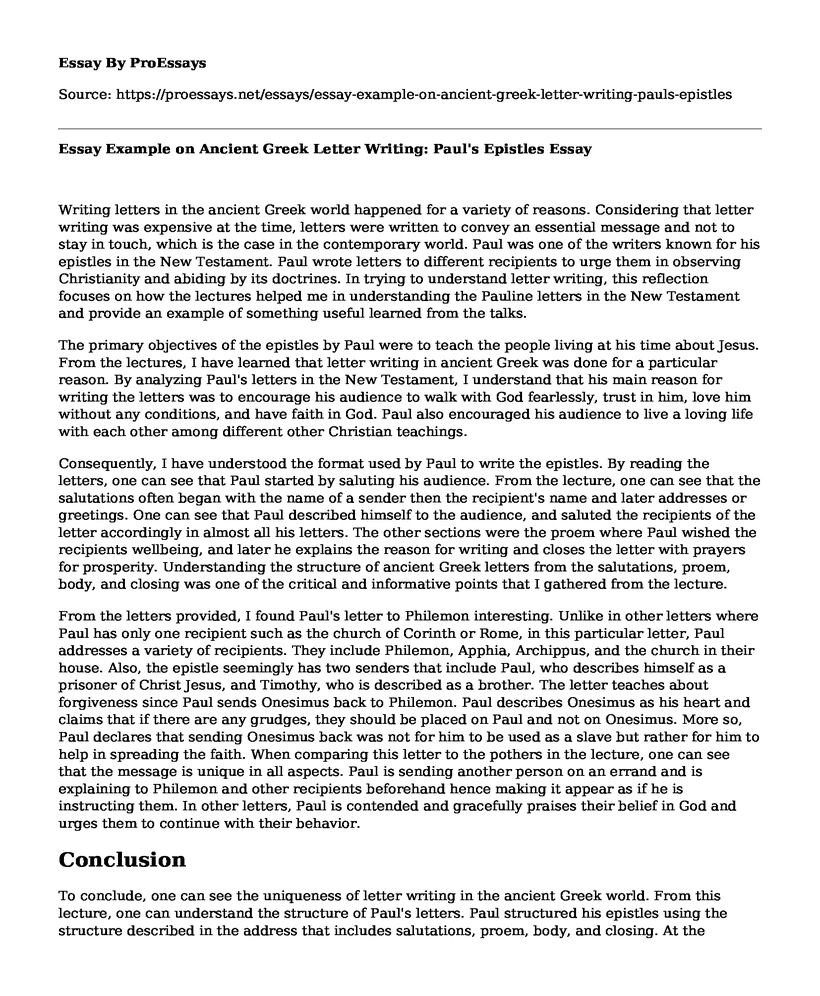Writing letters in the ancient Greek world happened for a variety of reasons. Considering that letter writing was expensive at the time, letters were written to convey an essential message and not to stay in touch, which is the case in the contemporary world. Paul was one of the writers known for his epistles in the New Testament. Paul wrote letters to different recipients to urge them in observing Christianity and abiding by its doctrines. In trying to understand letter writing, this reflection focuses on how the lectures helped me in understanding the Pauline letters in the New Testament and provide an example of something useful learned from the talks.
The primary objectives of the epistles by Paul were to teach the people living at his time about Jesus. From the lectures, I have learned that letter writing in ancient Greek was done for a particular reason. By analyzing Paul's letters in the New Testament, I understand that his main reason for writing the letters was to encourage his audience to walk with God fearlessly, trust in him, love him without any conditions, and have faith in God. Paul also encouraged his audience to live a loving life with each other among different other Christian teachings.
Consequently, I have understood the format used by Paul to write the epistles. By reading the letters, one can see that Paul started by saluting his audience. From the lecture, one can see that the salutations often began with the name of a sender then the recipient's name and later addresses or greetings. One can see that Paul described himself to the audience, and saluted the recipients of the letter accordingly in almost all his letters. The other sections were the proem where Paul wished the recipients wellbeing, and later he explains the reason for writing and closes the letter with prayers for prosperity. Understanding the structure of ancient Greek letters from the salutations, proem, body, and closing was one of the critical and informative points that I gathered from the lecture.
From the letters provided, I found Paul's letter to Philemon interesting. Unlike in other letters where Paul has only one recipient such as the church of Corinth or Rome, in this particular letter, Paul addresses a variety of recipients. They include Philemon, Apphia, Archippus, and the church in their house. Also, the epistle seemingly has two senders that include Paul, who describes himself as a prisoner of Christ Jesus, and Timothy, who is described as a brother. The letter teaches about forgiveness since Paul sends Onesimus back to Philemon. Paul describes Onesimus as his heart and claims that if there are any grudges, they should be placed on Paul and not on Onesimus. More so, Paul declares that sending Onesimus back was not for him to be used as a slave but rather for him to help in spreading the faith. When comparing this letter to the pothers in the lecture, one can see that the message is unique in all aspects. Paul is sending another person on an errand and is explaining to Philemon and other recipients beforehand hence making it appear as if he is instructing them. In other letters, Paul is contended and gracefully praises their belief in God and urges them to continue with their behavior.
Conclusion
To conclude, one can see the uniqueness of letter writing in the ancient Greek world. From this lecture, one can understand the structure of Paul's letters. Paul structured his epistles using the structure described in the address that includes salutations, proem, body, and closing. At the greeting, Paul describes himself and the recipient. In the proem, Paul wishes the recipients goodwill and well wishes. The body explains his reason for writing the letter while the closing ends with salutations and wishes of blessings and wellbeing. From this reflection, one can see that I found the letter to Philemon interesting when compared to the other epistles since it has more than one recipient and also the content was to provide instructions and plead with Philemon, which also makes it unique.
Cite this page
Essay Example on Ancient Greek Letter Writing: Paul's Epistles. (2023, May 23). Retrieved from https://proessays.net/essays/essay-example-on-ancient-greek-letter-writing-pauls-epistles
If you are the original author of this essay and no longer wish to have it published on the ProEssays website, please click below to request its removal:
- Essay Example on How Social Media Affect Teens
- "White People" Video Analysis Paper Example
- American Racial Patterns of Popular Music Essay
- Article Analysis Essay on The Space Traders by Derrick Bell
- Essay on Connection Between Culture, Subculture, & Film: Exploring the Relationship
- Paper Sample on Tom Cruise's Minority Report: Futuristic Crime-Fighting Technology
- Still Alice (2014) - Movie Review Sample







